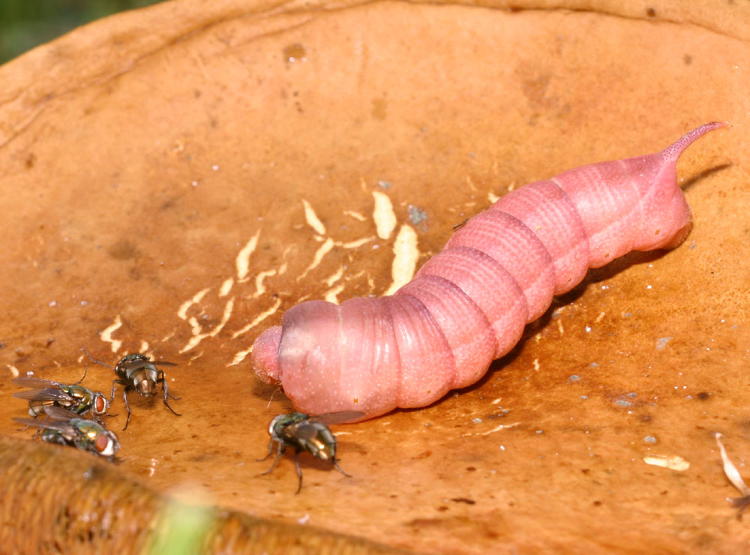This is more of a missing story, one that might have been, had I pursued it. Or simply one that lay underneath, that I was never going to determine.

This was taken back in September 2012, and it might be obvious that this is not the usual appearance of such critters. The pigmentation hides some of the characteristics that would help identify the species, but I’m inclined to say that it’s a tobacco hornworm, or more specifically the larva of the six-spotted sphinx moth (Manduca sexta,) but I’ll happily take correction on that. The reasons that I give for this tentative identification are a) I know we had the species around, earlier in the year in fact, and b) that curved horn instead of straight, which would indicate the other common hornworm. And no, it shouldn’t be bright pink.
What I believe is the case is a genetic mutation known as erythrism, also as erythrochroism, that seems to be most prevalent in katydids, which are pretty far removed from hornworms. Both of the common species of hornworms in the area are tomato-eaters, and their predominant color of lighter green blends in quite well with the stems of the plant, so this kind of color is obviously not very good camouflage. However, in some cases a lack of chlorophyll in the diet can lead to other pigmentation, so perhaps this was at work?
I don’t recall the exact circumstances of finding this one, and what I do remember seems rushed at best – I think I was heading somewhere and had almost no time to pursue this as a detailed subject. I’m almost certain that I found it on the porch, which was not close to any decent food plants, but really only about ten meters from the tomato plants in the garden, so there’s not a lot of excuse for this. I gathered the caterpillar up and posed it on a massive mushroom in the yard, getting some scale help from the blowflies, but I don’t think I even deposited it into the garden when done.
This is what kinda bugs me now. I would have liked to have had more information on it, and could have pursued two different actions: either put it onto the tomatoes and try to follow its life into pupation and emergence as an adult, to see if the pigmentation continued, or simply popped it into a jar of alcohol and brought it to the nearest entomologist – we have several universities nearby, so this wouldn’t have been difficult. Instead I just set it loose and never saw it again.
I almost certainly had my reasons at the time – I wasn’t that naïve, even seven years back – but since I don’t remember them now, I can curse my younger self for not doing the appropriate legwork.




















































